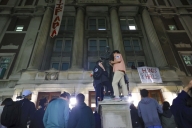You have /5 articles left.
Sign up for a free account or log in.

One-third of students surveyed from the Class of 2022 report not having had an internship or an experiential learning opportunity.
Sitthiphong/iStock/Getty Images Plus
The price tag for college continues to rise, while doubts about the work readiness of college graduates are rampant. This is very bad news for higher education, given the No. 1 reason Americans value a college degree is to get a good or better job. Not surprisingly, enrollments have been on the decline for 12 consecutive years. All the while employers struggle to find qualified applicants—and, most particularly, diverse, qualified applicants.
If you want to know what ails our labor market, all you have to do is look at data from students in the college talent pipeline. What it points to is a collective failure among colleges and employers.
We’re already suffering from the fact that this current generation of 18- to 24-year-olds is the least working in U.S. history. And fresh data from the Inside Higher Ed/College Pulse Student Voice survey (conducted with support from Kaplan) suggests little progress is being made to ensure graduates are well prepared for work. Nearly four in 10 (39 percent) college students and recent graduates surveyed have had neither an internship nor an experiential learning opportunity this past year. Isolating just the graduating Class of 2022, nearly one-third (30 percent) missed out on these precious experiences.
[block:block=176]
These stats are all worse for first-generation students. The majority of first-generation students (51 percent) missed out on experiential learning opportunities, while only 31 percent of non-first-generation students missed the same. First-generation students were also significantly less likely to have an in-person internship (28 percent) compared to non-first-generation students (41 percent).
Perhaps most insidious of all is the percentage of college students who had an unpaid internship. A whopping 43 percent of all students who had an internship in the past year were not paid. This is a practice that should be banned for the simple fact that it continues to perpetuate inequity in the workplace. If we want a more qualified, more diverse workforce, it begins with ensuring more underserved students have internships, and there’s one fundamental way to do that: more paid internships.
Higher education isn’t alone in needing to fix what ails us. Employers of all shapes and sizes need to step up. After all, what they want most from a college graduate is one with relevant job or internship experience. State and federal governments can and should provide more incentives (whether matching funds or tax subsidies) to encourage more paid internships offered by employers. And why not an addition to the Pell program to provide stipends for unpaid or low-paid internships?
Colleges and universities can take immediate steps of their own. Offering academic credit for internships is a big step in the right direction. This helps students understand the importance of such an experience. Unfortunately, only 14 percent of current college students received academic credit for their internship.
Higher education leaders can also put fundraising goals behind programs that provide stipends for unpaid or low-paid internships for underserved students. They can also audit their curricula and incorporate more experiential learning opportunities to ensure no student graduates without one.
Ultimately, there’s no fix to what ails our labor market until we fix the lack of work readiness and inequitable work-readiness practices in higher education.
More from the Student Voice survey on internships and experiential learning: What Students Want and Get From Internships








